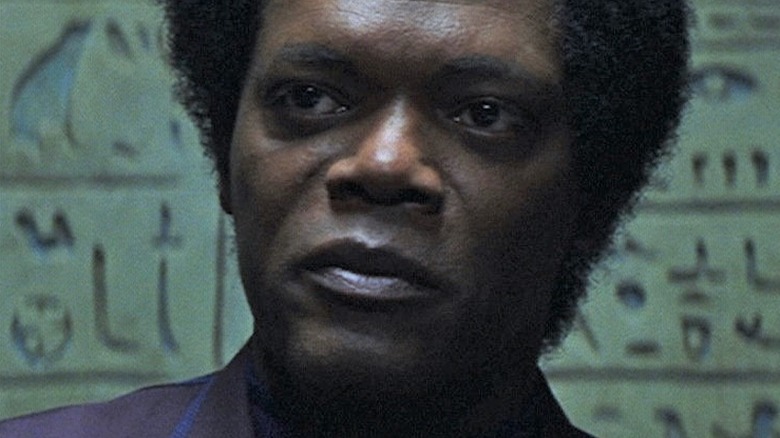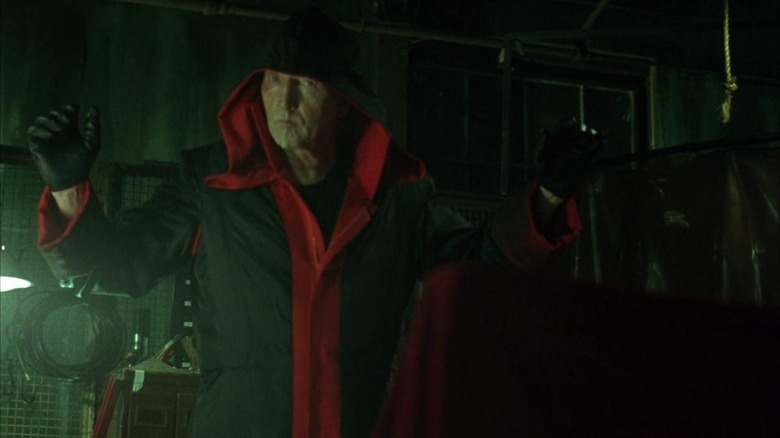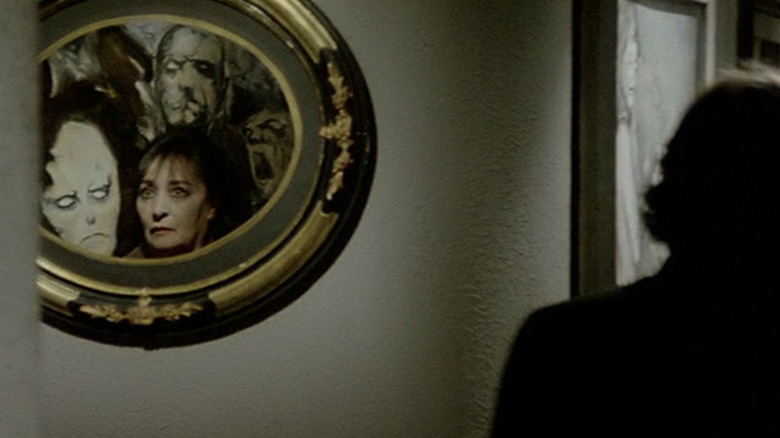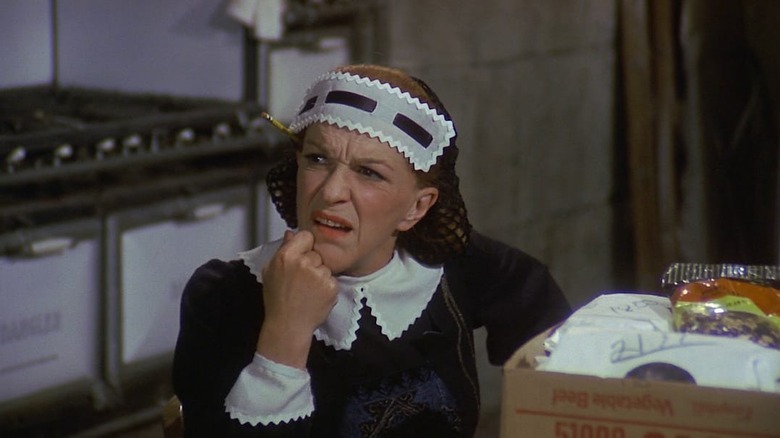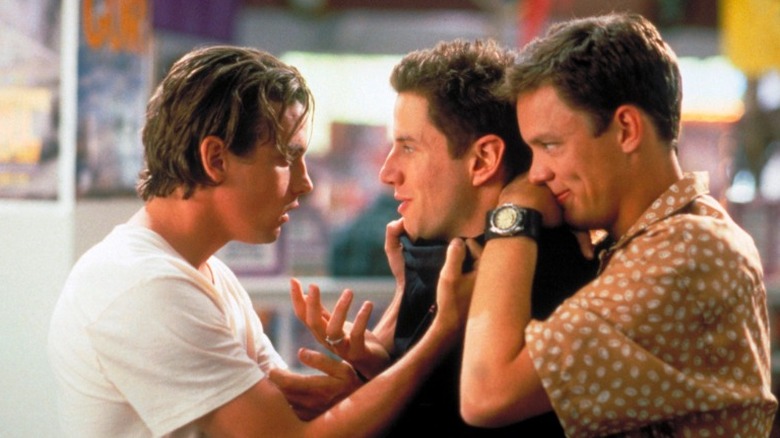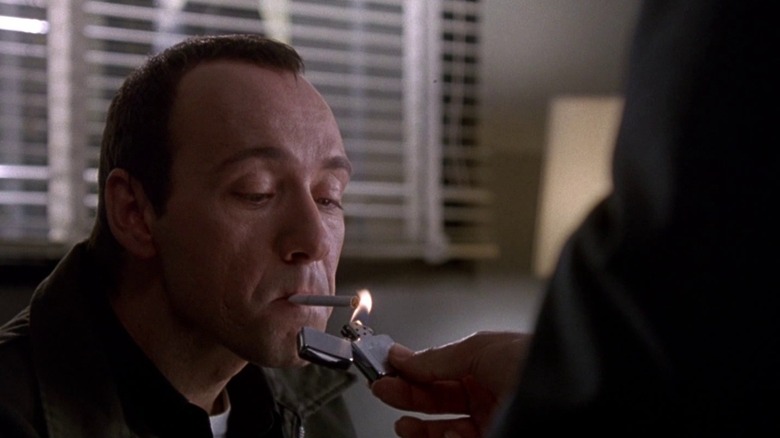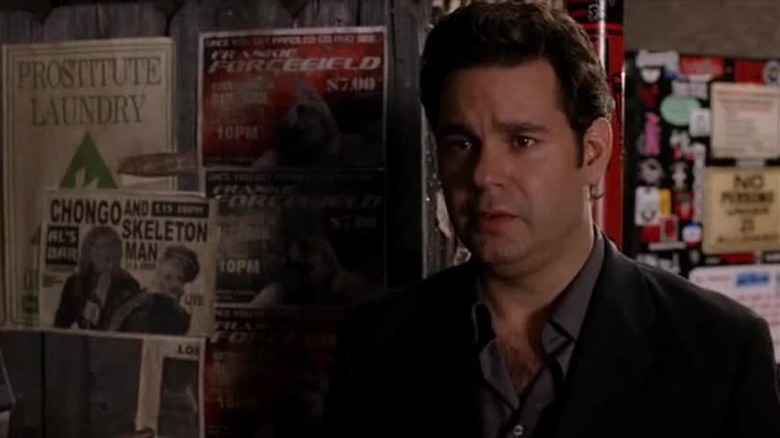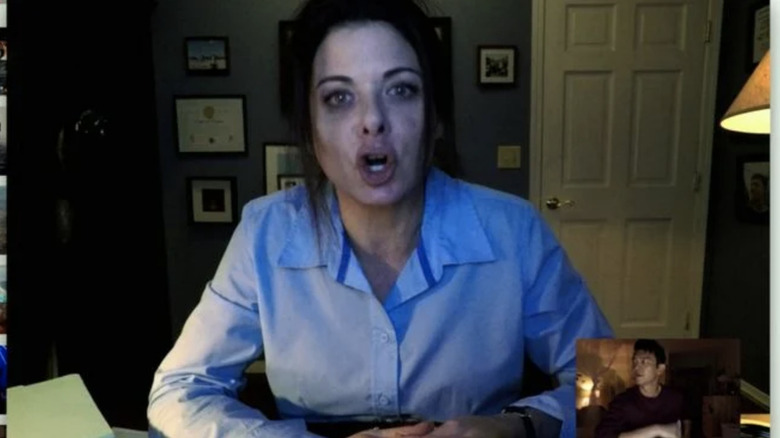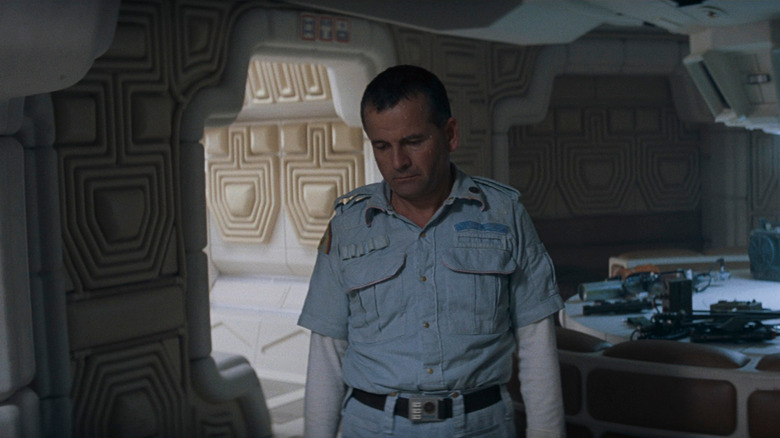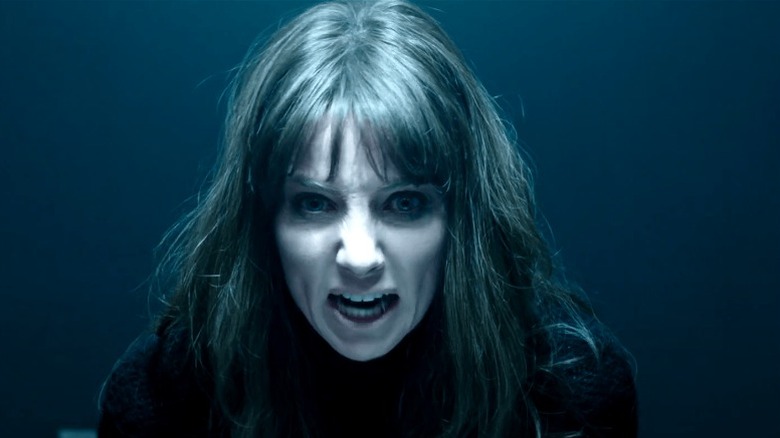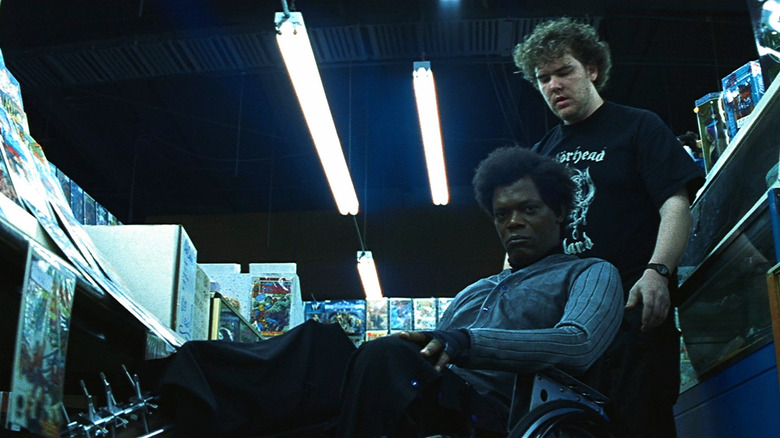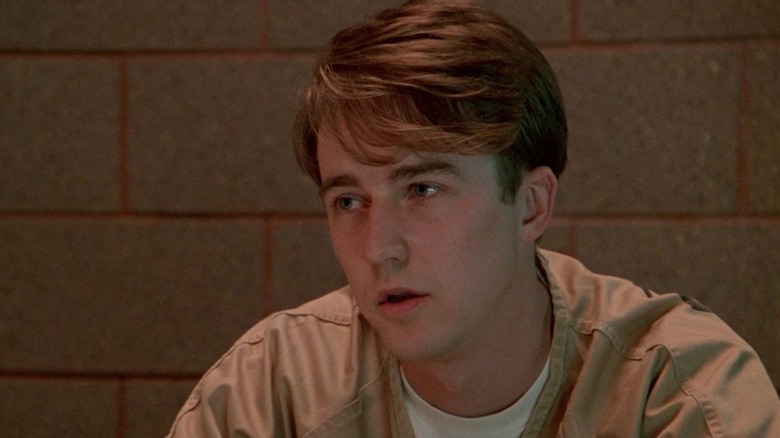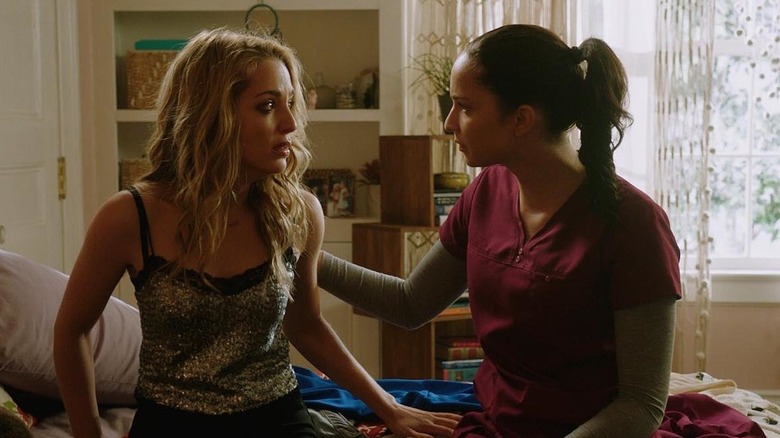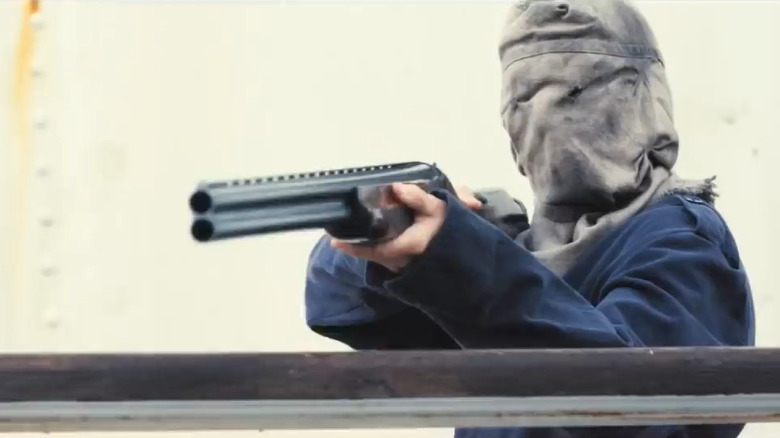Movie Villains That Were In Front Of Our Faces The Whole Time
In some films, villains twirl their greasy moustaches and relish in the fact that, yes, they are the Bad Guy. In others, the antagonist's identity is part of the mystery — a riddle to solve, often in the film's climactic moments. From horror films to dark comedies to nail-biting thrillers, plenty of films wait until the 11th hour to reveal who's been pulling the strings and triggers (but not the punches).
And when it comes to left-field villain twists, one of the best (and most shocking) instances is when we learn that someone who's been right under our noses this whole time has secretly been the baddie. They seemed so kind and trustworthy before they confessed to all those murders, we swear!
This goes without saying, but it really must be stressed that the following list contains full story spoilers. Though, if you clicked on this article, we'd reckon a guess that you're the kind of person who doesn't sweat that kind of thing (or maybe you're a huge film buff, and you're pretty sure you've seen enough movies to take the risk). In any case, consider yourself warned and prepare to develop trust issues as we list the most shocking times where movie villains were right in front of our faces.
John Kramer in Saw
It's a bit of a head-trip to think back to the year 2004 when the first "Saw" film kicked down the proverbial door. Co-creators James Wan and Leigh Whannell have gone on to cement their status as modern-day genre film royalty. And nine feature films later, and after several sharks jumped, the franchise's humble beginnings feel like a quaint and distant memory, so let's think back to that dingy, filth-stained bathroom, shall we?
"Saw" begins with two strangers — surgeon Dr. Lawrence Gordon (Cary Elwes) and freelance photographer Adam Stanheight (Whannell) — waking up in what appears to be some uncharted circle of hell. Chained by their ankles on opposite sides of a disgusting room, the pair are separated by a rotting corpse face down in a pool of blood, clutching a tape player and a gun. After playing their respective tapes, their objective is made plain by a sinister, distorted voice: Dr. Gordon must kill Adam within seven hours, or his wife and daughter will die. The pair realize that they have become the latest victims of the Jigsaw Killer, a murderer with a love of sick, twisted games that promise escape ... but not without sacrifice.
And unbeknownst to our hapless pair, in addition to all the disembodied trickery, the Jigsaw Killer (aka John Kramer) is in the room with them. Quite literally. In the film's climactic moments, the "corpse" in the center of the room shudders, lets out a long breath, rises to his feet, and removes his latex death mask. A terminal cancer patient hellbent on reminding his victims to value their lives (by making them stare death in the face), Kramer informs Adam that the game is over and that he has lost. The lights go out, and Kramer slams the door to the death trap.
Martha Manganiello in Deep Red
If you ever need reminding that magic does exist, look no further than the sleight of hand in Dario Argento's 1975 masterpiece, "Deep Red." Arguably the high watermark of giallo, the uber-stylish Italian thrillers that take their name from yellow Italian murder-mystery paperbacks, "Deep Red" embodies many of the hallmarks of the genre. Black leather gloves, candy apple red bloodstains, and, uh, imaginative dubbing abound. Giallo films are also known for boasting more red herrings than a fish market. This, coupled with the genre's enthusiasm for gender parity as far as villains are concerned, means that anyone can be (and often is) the killer.
"Deep Red" follows an unlikely sleuth, a jazz pianist named Marcus (David Hemmings), who becomes involved in a murder case when he witnesses the violent death of a psychic who more or less predicted her own death at a public event that same evening. As the caper chugs along, suspects begin to emerge out of the woodwork — maybe it's the bold, streetwise journalist (Daria Nicolodi) or Marcus' constantly inebriated friend (Gabriele Lavia). Again, it could be anyone!
However, if you were paying very close attention during the inciting incident of "Deep Red," when Marcus enters the psychic's apartment after witnessing her murder, you've already seen the culprit. Yes, while Marcus makes his way down an eerie hallway of contorted painted faces and oblong mirrors, the killer's face is reflected right before our very eyes — the sweaty, pallid face of Martha (Clara Calamai), Carlo's seemingly harmless mother. Revealed as the killer in the film's 11th hour, Argento plays back the scene from earlier in the film to remind us that we'd all make terrible eyewitnesses. Thanks, Dario.
Lionel Twain in Murder by Death
It is possible, within reason, to sniff out a number of the sneaky villains on this list before their official reveal. This is not the case with "Murder by Death." But, as we'll explain, this isn't necessarily a bad thing.
A low-brow satire stuffed to the gills with groan-inducing jokes, "Murder by Death" comes courtesy of the incredibly talented playwright and screenwriter Neil Simon (who also wrote the film's noir-mocking sequel "The Cheap Detective"). The film's premise is a doozy so make sure you're holding on to something solid: Five renowned detectives (each a pastiche of a famous fictional detective, from Hercule Poirot to the hardboiled Sam Spade) are summoned by the eccentric and hilariously wealthy Lionel Twain (Truman Capote) to dine at his remote mansion. Twain offers the detectives a prize of $1 million if they can solve a murder that will take place at the stroke of midnight. When the murder turns out the be Twain's own murder, the increasingly chaotic hunt is on. Amidst all the secret passageways, booby-trapped rooms, blind butlers, and deaf-mute maids, it quickly becomes apparent that while the killer is absolutely under our noses, there is no way even the greatest detective could sniff out this mystery.
Sure enough, the ultimate reveal proves that (1) the killer was amidst the group the whole time, and (2) there was no way that anyone could guess who it was. At first, it appears that Bensonmum, the not-so-blind butler played by Alec Guinness, did it. Several disguises within disguises later (a chaotic nesting doll of reveals that must be witnessed firsthand), Bensonmum removes his latex mask to reveal that he is, in fact, Lionel Twain himself, berating the detectives for annoying their loyal readers with ridiculous twist endings. Then, right before the credits roll, Twain removes another mask to reveal that they were the maid (Nancy Walker) the whole time. Does anyone else's head hurt?
Billy and Stu in Scream
The mask-wearing Ghostface killer is on the loose, plunging kitchen knives into the sternums of any high schooler unfortunate enough to utter the phrase "who's there?" As the mystery unfolds and the curfews intensify, our heroine Sidney Prescott (Neve Campbell) begins to suspect that somehow the killings have something to do with the death of her mother, which took place a year before. While signs point both to the convicted killer, Cotton Weary (Liev Schreiber), and even to her own boyfriend, Billy (Skeet Ulrich), Sidney's grasp on who's out to get her and her friends is never firm enough to make a confident accusation. In the end, we learn that Billy was indeed behind the killings, feigning innocence with the help of an accomplice, Stu (Matthew Lillard).
While, unfortunately, we can't watch Wes Craven's 1996 slasher satire for the first time again, the good news is that repeat viewings reward the attentive viewer with subtle hints as to the killers' identities. When Billy and Sidney get intimate, you can spot her villainous boyfriend eyeing the door to make sure that Stu has a way in later. Randy (Jamie Kennedy), the film's voice of reason, correctly identifies Billy and Stu as the killers not once but twice. It's also clear (if you're looking for it) that Ghostface knows their way around Stu's house ... like they live there or something.
Verbal Kint in The Usual Suspects
Mild-mannered surviving witness Roger "Verbal" Kint (Kevin Spacey) is brought in to testify before two special agents hot on the heels of a mysterious gangster known as Keyser Söze. With the sweet, sweet promise of immunity dangling before him, Verbal lives up to his name and proceeds to spill the beans, telling a thrilling and increasingly convoluted tale of drug deals gone wrong, boat hijackings, and rival Hungarian gangs.
After Verbal finishes weaving his yarn and departs the building with immunity secured, the not-so-bright cops realize all too late that all the details of his tale were inspired by various objects around the room, from coffee cups to wanted posters. It was all very compelling bit of improv. And the fuzz fell for it. Then, a final gut punch — a police artist impression of Keyser Söze arrives on cue by fax for dramatic effect. While the sketchy face of Verbal Kint looks up at the cops, the crook's limp vanishes, and he rides off into the proverbial sunset.
While the final twist of "The Usual Suspects" certainly reeks of that "it was all a dream" quality that can make viewers feel cheated, there's no denying this finale's infamy. And for that reason alone, Verbal's tall tale earns the film a spot on this list. You just have to respect the grift.
Satan in Tenacious D and the Pick of Destiny
The greatest trick the devil ever pulled was convincing the world that he was actually an open mic host played by beloved comedian Paul F. Tompkins. In this 2006 rock opera, real-life best friends/musical duo JB (Jack Black) and KG (Kyle Gas) are literally hellbent on proving the worth of their band, Tenacious D. To do so, they must steal the Pick of Destiny, a magical guitar pick fashioned out of Satan's tooth that endows its user with supernatural musical abilities.
After much adventuring and band drama (as well as a hallucinogenic romp with Bigfoot ... don't ask), the duo obtain the fabled pick, only to snap it in half while having a spat. Luckily, the kindly open mic MC — who has been a total sweetie this whole time — is there to assure them that the magic of music was inside them the whole time. What a nice guy!
Just kidding, he's actually Satan, who wants his missing tooth back so he can reign damnation down on Earth. After being challenged to a rock-off (which the Devil must accept due to demon law), a musical showdown ensues that ultimately leaves Satan "incomplete" once again, as his horn gets blasted off when JB defends KG from a lightning bolt. The power of friendship prevails!
Rosemary and Robert Vick in Searching
In this screenlife thriller from 2018, we follow bereaved father David Kim (John Cho) as he investigates the sudden disappearance of his teenage daughter, Margot (Michelle La). While the police investigation — headed by revered detective Rosemary Vick (Debra Messing) — does its thing, David does what any distressed parent would do and roots through his daughter's laptop for clues. While Vick's investigation seems to suggest that Margot was leading a very different life behind her father's back and that she ran away, David can't shake the conviction that his daughter would never do something like that.
Despite Vick's protests, David continues to involve himself in the investigation. And just when it appears that the case has finally been solved (a homicidal ex-con did it!), David stumbles across evidence that suggests Margot was being catfished by someone pretending to be a shoulder to cry on after the death of Margot's mother. With some further prodding, the truth finally comes out: Vick's son, Robert (Steven Michael Eich), was the catfish and pushed Margot down a ravine after surprising her in real life. All of Vick's "legit" police work was an attempt to cover up her son's mistake. Consider this your reminder to be wary of getting emotionally involved with strangers on the internet, folks.
Ash in Alien
One of the things that distinguishes Ridley Scott's 1979 sci-fi horror film is the working-class nature of its cast. The crew of the Nostromo isn't made up of clean-cut engineers or square-jawed swashbucklers. They're blue-collar workers on a commercial towing vessel, with far more in common with oil riggers or longshoremen than heroic, spacefaring explorers. This is just a job to them. And much of the film's horror — lurking in the background of H.R. Giger's undulating creature designs and all the invasive body horror of the Xenomorph's gestation — hinges on this point: The working class is expendable. As the BFI's 40-year retrospective astutely puts it, "In space, no one can hear your plea for workers' rights."
As if a killer, acid-blooded alien running amok wasn't bad enough, the intrepid Ripley (Sigourney Weaver) soon discovers the truth — all this carnage was actually all part of their employer's plan. And while the faceless Weyland-Yutani conglomerate doesn't formally rear its corporate head until the sequel, "Alien" does have a sleeper agent amidst the crew to ensure that retrieval of this precious, multi-mouthed asset goes to plan: Ash (Ian Holm). Not only does it turn out that the mild-mannered science officer is an android (the class traitor!), his true purpose is to explicitly ensure the interests of the company, crew be damned. As the synthetic face of the film's true villain (which, wouldn't you believe it, isn't the horrible killer alien), Ash's covert presence more than secures his spot on this list.
Gabriel in Malignant
There are villains that bide their time right in front of your face, and then there's Gabriel, the fleshy antagonist of James Wan's incredible horror flick "Malignant." A blank check of a movie if ever there was one, Wan's film pays homage to a delightfully bananas amalgam of genre film giants, from Dario Argento to Frank Henenlotter. And if you're keyed into Wan's nods to Henenlotter's work — especially the latter's 1982 creature feature "Basket Case," which sees a young man carting his murderous conjoined twin around in a wicker basket — you may be able to divine where "Malignant" is head-ed (pun intended).
"Malignant" follows a woman named Madison (Annabelle Wallis) who begins experiencing horrifying visions of real-life murders after her abusive husband shoves her against a wall. Madison's connection to the leather-clad, trench coat-wearing, stringy-haired killer is not totally clear. But as the clues steadily begin to fall into place, it seems that "Gabriel," Madison's sinister imaginary friend from when she was a child, has something to do with it.
Even if you've been around the horror block, you might not be able to telegraph the third-act rug pull of "Malignant," which takes place in a jail cell full of hapless souls who are about to witness one of the most radical action scenes of the 21st century. While cross-cut scenes play out of the detectives uncovering the awesome truth through good old-fashioned research, we get to witness the bloodbath firsthand: Gabriel is a tumor that lives in the back of Madison's skull — a souped-up, parasitic teratoma that shares Madison's brain and peaks through her noggin to hijack her body when he wants to commit carnage. Talk about a head trip.
Mr. Glass in Unbreakable
Released in the year 20000, M. Night Shyamalan's covert superhero thriller follows retired football player David Dunn (Bruce Willis), who shockingly emerges unscathed from a train crash that killed every other passenger on board. Just as Dunn begins to suspect that there might be something different about him, he is contacted by Elijah Price (Samuel L. Jackson), a medically frail comic book aficionado who believes that fictional superheroes have some basis in reality. Encouraged by his son (and Elijah), David dons a rain poncho and begins to experiment with vigilantism, thwarting thieves and murderers with ease, thanks in part to an uncanny ability to detect future wrongdoing by coming into physical contact with would-be perps.
It's through this power that David, in the film's final act, learns the horrible truth about Elijah or, as he would rather be known, Mr. Glass. While attending Elijah's art show, David shakes his friend's hand and is bombarded with visions of terroristic acts ... including the train derailment that first clued David into his incredible powers. Embracing his status as David's arch-nemesis, Elijah announces that he will act as a worthy adversary to David's heroics ... only to promptly wind up in a mental institution per an epilogue before the credits roll.
Aaron / Roy in Primal Fear
In "Primal Fear," a seemingly sweet 19-year old named Aaron has been accused of murdering a locally revered archbishop, prompting the limelight-loving defense attorney Martin Vail (Richard Gere) to take the teen's case on for free. While initially drawn to the fame of being associated with such a high-profile case, Vail steadily begins to suspect that his client might actually be innocent. After all, there were plenty of folks who would've liked to see the archbishop dead. The man ran afoul of corrupt politicians and was a serial sexual abuser, after all.
That said, the case isn't looking good for Aaron, who had a motive as one of the archbishop's victims and was literally seen fleeing the crime scene covered in blood. But Aaron doesn't remember the murder, and despite his better judgment, Vail believes him.
Later, it turns out that the reason Aaron doesn't remember committing the murder was that he didn't kill the archbishop ... his repressed, ultra-violent alter-ego Roy did. Insanity plea secured, right? A tragic figure who didn't know what he was doing, right? Wrong. In the final knife twist, we learn that Roy wasn't a figment of Aaron's fractured psyche. Heck, Roy wasn't even an act. It was "Aaron" that was made up, not Roy. Does anyone have any Tylenol on hand? Our heads hurt.
Angela/Peter in Sleepaway Camp
Perhaps one of the most infamous third-act villain reveals in horror history, the controversial final twist of "Sleepaway Camp" has rightfully received its fair share of criticism over the years. Robert Hiltzik's 1983 campy summer camp slasher follows 14-year-old Angela Baker (Felissa Rose), an incredibly shy young girl whose parents and sibling perished tragically in a boating accident when she was just a child. Raised by her eccentric aunt, Angela is off to spend her summer at camp with her cousin, Ricky (Jonathan Tiersten). As if the constant bullying weren't enough, Angela's timid attempts to overcome her shyness are thwarted by the presence of an unknown killer, who's massacring members at the camp with reckless abandon.
While several characters point fingers at Ricky, who they argue committed the murders to defend his victimized cousin, the ultimate reveal is less of a left turn than a full-blown barrel roll. Not only did sweet, quiet, timid Angela commit the murders, but "Angela" is actually a boy, who his deranged aunt raised as a girl. While the film's villainization of trans people as deranged maniacs is gauche, to put it lightly (we could quite literally make a whole list out of bad faith twist endings where the killer is revealed to be another gender), there's no denying that the final moments of "Sleepaway Camp" contain one of the most shocking villain reveals out there.
Lori in Happy Death Day
A 2017 campus-set horror-comedy arguably features more death scenes than any film on this list, "Happy Death Day" is what you get when you put "Groundhog Day," "A Christmas Carol," and "Scream" in a blender. The film follows Tree (Jessica Rothe), a snarky, mean-spirited sorority girl who finds herself trapped in a time loop, repeating the day of her death (which also happens to be her birthday) over and over again. While Tree spends each birthday pursued by a homicidal maniac wearing the extremely creepy mask of their school's baby-faced mascot, she puts her many, many lives to use attempting to (1) become a better person and (2) figure out who has been killing her over and over again.
Unfortunately, Tree has no shortage of enemies. And while her mother's murderer and the psychopathic teacher she's been sleeping with are prime suspects, it turns out that Tree's kind, buttoned-up roommate Lori (Ruby Modine) has been behind the knife-wielding nightmare this whole time. Whenever Tree didn't eat the poisoned cupcake Lori made for her (aka almost every day in the time loop), the bloodthirsty med student set the killer of Tree's mother's loose to do her dirty work for her. All this over some boy? Lori, we expected more from you as one of the only seemingly decent people in this movie. Lesson learned: Appearances can be deceiving!
Jess in Triangle
Yeah, okay, so we literally just mentioned one murder-mystery time loop film. But this one takes place on a cruise ship rather than a college campus, so we have no problem doubling up. Speaking of doubling up, that's basically the gist of the chilling twist behind 2009's "Triangle."
The film follows Jess (Melissa George), a single mom who joins pals on a sailing trip to blow off some steam. What begins as a cute weekend getaway soon devolves into a nightmare when a mysterious electrical storm capsizes their boat. Then, when an ominous, massive cruise ship drifts into view, the survivors clamor aboard to find the vessel deserted ... or so it seems. It soon becomes apparent that a masked, shotgun-toting killer is stalking them for reasons unknown. As if all that wasn't enough to take in, Jess can't shake the feeling that she's been here before. Only that would be impossible, right?
Then, in the second half of the film, we're let in on the killer's dark secret: The killer is Jess. Finding herself trapped in a time loop where a means of escape is unclear, Jess repeats the murderous acts of the killer (who was her in another time loop) in hopes of seeing her son once again. While she does technically succeed in reuniting with her boy, her attempts to escape the cycle of violence are thwarted. Maybe it would have been better if Jess had just stayed at sea.
